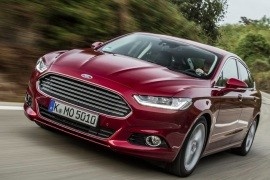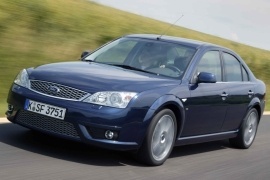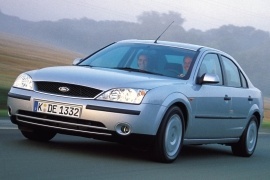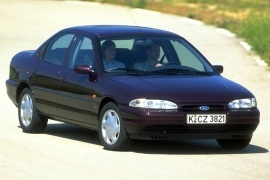
FORD Mondeo Sedan
Generations Timeline, Specs and Pictures

The first generation of the Mondeo is over 20 years old and its offspring was at its fourth generation in 2015.
And it was, finally, a world car.
Ford tried to do a car that could sell well on both sides of the Atlantic. It tried with the Mondeo in 1994 with Mondeo in Europe and Countour/Mercury Mystique in the U.S. But it wasn’t a hit. But it worked its way through and in 2015 the fourth generation seemed to do well. The secret was to install adequate engines on each continent. But the shape was good, with sort of aggressive lines and three body styles: sedan, hatchback and station wagon.
Apart from the first generation, all the Mondeo vehicles were spacious inside, with enough room for five passengers. The sedan was a good choice for everything. It was good for fleets, for rentals, and company cars. In the U.S., it was known as Ford Fusion and had some different design cues. But since it was built on the same Ford CD4 platform, it was easy to manage the costs. The interior featured enough options for every taste, including the Syng connectivity and infotainment system.
In Europe, the base engine was the acclaimed 1.0-liter EcoBoost that offered 125 hp. In theory, it was strong enough, but it was offered only in a few countries where the tax difference was worthy. A hybrid version was also offered, in the Vignale upper trim level.

After a brief appearance in the James Bond Casino Royale movie in 2006, Ford unveiled the fourth generation of the Mondeo in the following year.
Ford built the Mondeo on the same platform as the Mazda 6/Atenza, and it was not available in the U.S., like the first generation where the Contour model filled that segment. The vehicle was available as a four-door sedan, five-door hatchback, and a station-wagon. It was shown as a static display in late 2006 with the official launch in 2007.
Featuring a new design language, named kinetic-design, the Mondeo represented Ford’s biggest car on the European market. Its front grille left the rounded sides of the trapezoidal shape from its predecessor and adopted sharper, straight lines. On the other hand, the swept-back headlights featured a bigger interior side. A wider lower grille was installed on the apron. Unusually, the sedan was the longest version from the 2007 Mondeo lineup.
The Mondeo offered a roomy interior due to its long, 2.85 m (112.2 in) wheelbase. Inside the dashboard, there were two analog dials and a central TFT screen. For the infotainment unit, Ford allowed a sat-nav system with voice commands as an option. The base models featured a CD-stereo unit.
Under the hood, Ford installed a wide choice of gasoline or diesel engines. They ranged from a mere 1.6-liter 115 hp turbodiesel up to a 2.0-liter turbocharged gasoline unit that offered 240 hp. Most versions were mated to a 6-speed manual, while a 6-speed automatic was on the options list.

The second generation of the Mondeo went through two mild facelifts instead of a major one.
In 2005 it was the last one, before the third generation which Ford launched in 2007.
Ford didn’t want to lose the momentum gained by its mid-size sedan on several markets, even though there were some countries where Volkswagen was miles ahead of it with the Passat range. In the three-box sedan version, the Mondeo was one of the favorite vehicles for fleets.
The Mondeo’s second generation was a hit with its triangular headlights swept over the hood and the slim curved trapezoidal grille. It was introduced to the market in 2000, but its design was not outdated. Still, Ford decided to do a facelift on it and slightly changed the front bumper and the headlights.
Inside, the Mondeo sedan was good looking with its dashboard that offered the same two big dials for the tachometer and speedometer and two small LCD displays on the bottom of them. A nice touch of luxury feel was the oval clock on the center stack, above the optional infotainment system, which featured a CD and sat-nav. Since the Mondeo was well known for its speed cornering abilities, the carmaker decided to install higher bolstering on the front seats, to keep the occupants in place. In the back, the Mondeo sedan offered more than enough legroom and headroom.
The 2005 model received a new engine lineup, including the Duratorq diesel engines offered in four different power outputs.

Ford introduced the first facelift for the second generation of the Mondeo in 2003, after just two years and a half from its launch, in November 2000.
While it was still a market leader in some countries, the Mondeo MKII received an update in the summer of 2003. The carmaker introduced new features and a few changes to the interior. The change was not necessary for the drivetrain since the following pollution norms were introduced in 2005 when Ford launched the second facelift for a car that lasted only seven years on the market.
From the outside, the only noticeable change was for the grille, which featured a chrome surrounding and a honeycomb mesh grille. The bumper was enhanced as well, with the introduction of larger fog-lights in different casings. On the sides, the turn-signals that were mounted on the fenders were transparent instead of orange. In the back, the taillights featured transparent lenses for the turn-signals on 2003 model-year instead of red.
Inside, Ford enhanced or changed some parts to improve the car’s quality. For instance, it signed a deal with Sony to provide the CD-radio unit, which was much better integrated into the center stack. Other buttons and switches received an improved design.
For the engine lineup, Ford dared to introduce a 3.0-liter gasoline V6 unit for the top version. Since the European diesel market was increasing and became very attractive for fleets, the blue-oval brand enhanced the 2.0-liter TDCI unit to produce 155 hp instead, 25 hp more than its predecessor.

Ford introduced the second generation of the Mondeo in 2000, and it was striking with its New-Edge design language that brought a more dynamic look for the medium-sized sedan.
The carmaker changed the Mondeo lineup with a larger, more comfortable vehicle and offered it in three body shapes: four-door sedan, five-door hatchback and station wagon. The sedan was considered a very good middle-management vehicle. Its wide range of options and features transformed it into the main weapon against the Volkswagen Passat, but eventually, the blue-oval brand had to admit that it lost the battle against the German rival.
On the outside, the Mondeo featured a mesh-grille at the front and triangular, swept-back headlights. A two-slats lower grille was installed in the lower bumper area. Depending on the trim selected, Ford installed fog-lights in the front bumper. The vehicle’s designers made an ascending beltline that created a dynamic image for the Mondeo sedan.
Even though the Mondeo was considered the flagship for the European market, Ford didn’t try to make it look different. It featured a sound system with a cassette player and a simple radio function. The buttons’ design was clearly way under the car’s target. Later on, it included a CD-player in the options list.
Ford installed a very wide choice of engines, both gasoline and diesel-powered. For selected versions, the carmaker offered an automatic transmission.

The Mondeo was designed as a world car.
A stylish, yet practical 4-door vehicle. For this model, Ford focused on safety and handling. The car was equipped with seat-belt pretensioners, ABS, and for the more advanced trim level, the Ghia had traction control available, a system which removes unwanted wheel speed. The interior noise was reduced, as the car had a perfect balance between noise, vibration and harshness. Even the door mirrors were created in such a way not to create interior noise, aside from their efficiency and style.
The car was created as a front wheel drive and was equipped with 16-valve engines, as they were quieter and more performant. The transmission was available in both manual and automatic.
Another nice optional feature was the adaptive damping which allowed to shift to a firmer suspension in turns. The instrument panel was revised. A cruise control system was added and it had the tap up, tap down facility. The car also had heated front seats available. Every control and knob could easily be reached by driver.
The steering wheel was telescopic so that it was easy to adapt the driving position for each and every height. The sun visor was equipped with a vanity mirror, with light and bright dim. The car was also equipped with remote control locking and an illumination entry system.
The Ford Mondeo was the most important car Ford ever made.























































